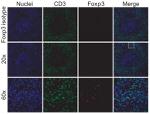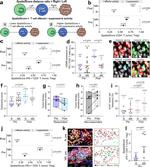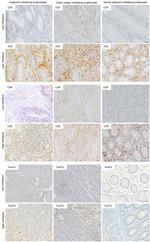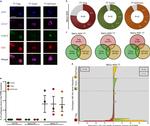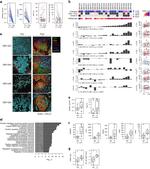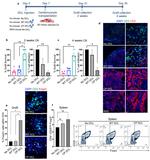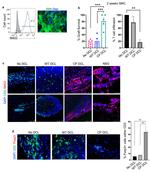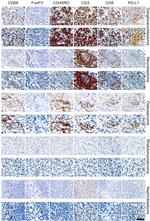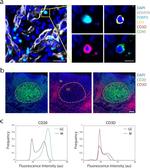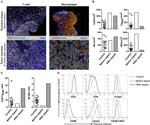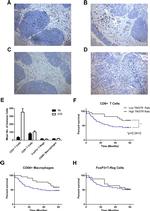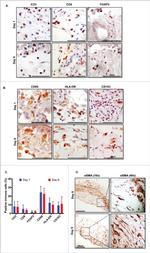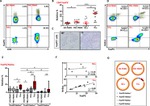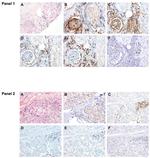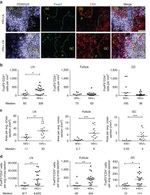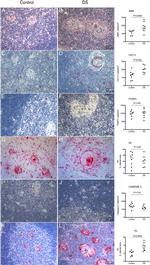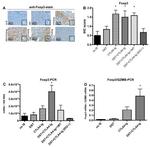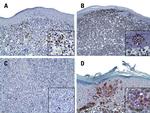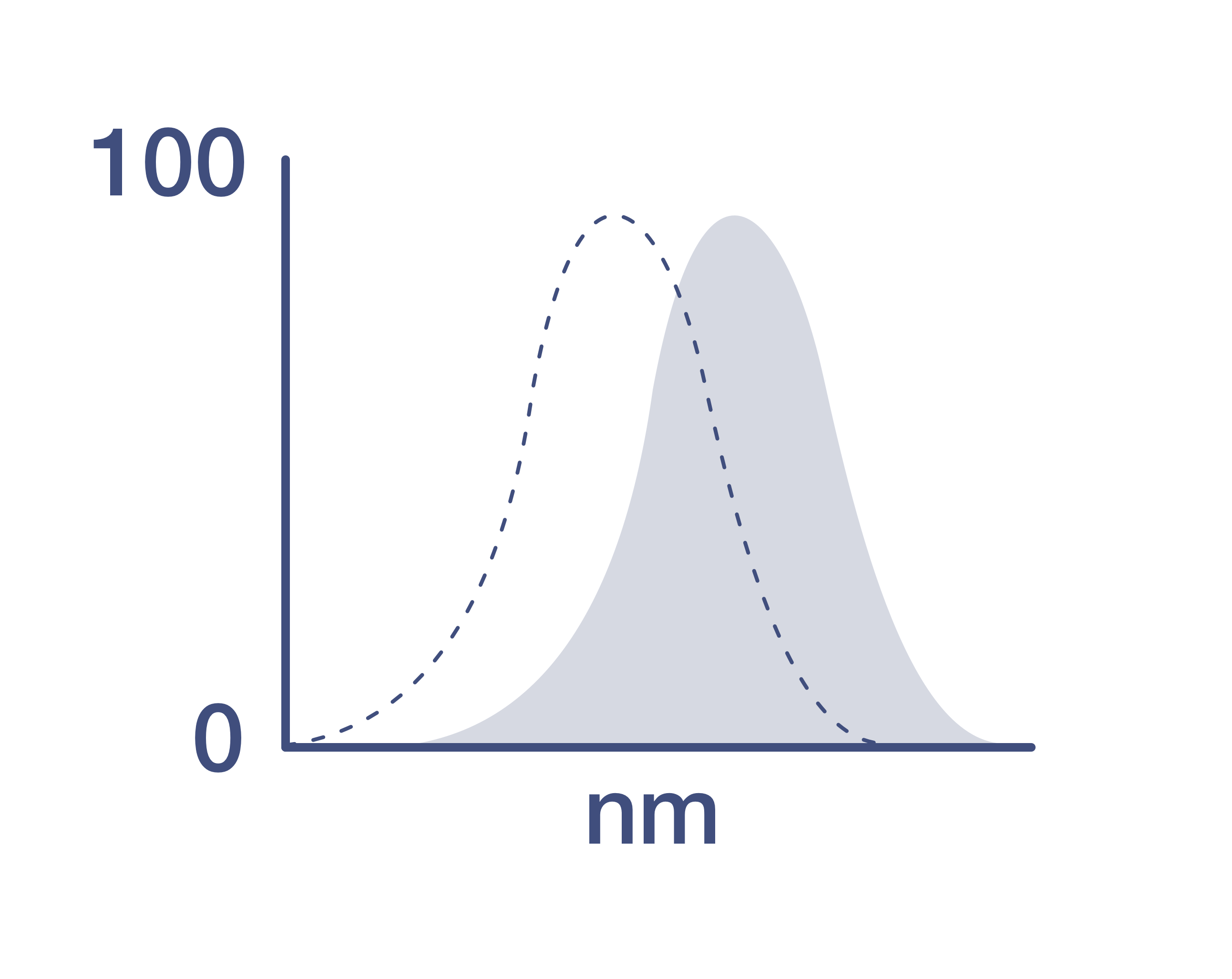Product References
Tumor microenvironment shows an immunological abscopal effect in patients with NSCLC treated with pembrolizumab-radiotherapy combination.
Journal for immunotherapy of cancer
van der Woude LL,Gorris MAJ,Wortel IMN,Creemers JHA,Verrijp K,Monkhorst K,Grünberg K,van den Heuvel MM,Textor J,Figdor CG,Piet B,Theelen WSME,de Vries IJM
Published figure using FOXP3 monoclonal antibody (Product # 41-4777-82) in Immunohistochemistry
Sat Oct 01 00:00:00 EDT 2022
Common clonal origin of conventional T cells and induced regulatory T cells in breast cancer patients.
Nature communications
Xydia M,Rahbari R,Ruggiero E,Macaulay I,Tarabichi M,Lohmayer R,Wilkening S,Michels T,Brown D,Vanuytven S,Mastitskaya S,Laidlaw S,Grabe N,Pritsch M,Fronza R,Hexel K,Schmitt S,Müller-Steinhardt M,Halama N,Domschke C,Schmidt M,von Kalle C,Schütz F,Voet T,Beckhove P
Published figure using FOXP3 monoclonal antibody (Product # 41-4777-82) in Immunohistochemistry
Thu Feb 18 00:00:00 EST 2021
Increased CD3+, CD8+, or FoxP3+ T Lymphocyte Infiltrations Are Associated with the Pathogenesis of Colorectal Cancer but Not with the Overall Survival of Patients.
Biology
Barbosa AM,Martinho O,Nogueira R,Campos J,Lobo L,Pinto H,Longatto-Filho A,Castro AG,Martins SF,Torrado E
Published figure using FOXP3 monoclonal antibody (Product # 41-4777-82) in Immunohistochemistry
Fri Aug 20 00:00:00 EDT 2021
Immune cell topography predicts response to PD-1 blockade in cutaneous T cell lymphoma.
Nature communications
Phillips D,Matusiak M,Gutierrez BR,Bhate SS,Barlow GL,Jiang S,Demeter J,Smythe KS,Pierce RH,Fling SP,Ramchurren N,Cheever MA,Goltsev Y,West RB,Khodadoust MS,Kim YH,Schürch CM,Nolan GP
Published figure using FOXP3 monoclonal antibody (Product # 41-4777-82) in Immunohistochemistry
Thu Nov 18 00:00:00 EST 2021
Multiple Immunostainings with Different Epitope Retrievals-The FOLGAS Protocol.
International journal of molecular sciences
von Schoenfeld A,Bronsert P,Poc M,Fuller A,Filby A,Kraft S,Kurowski K,Sörensen K,Huber J,Pfeiffer J,Proietti M,Stehl V,Werner M,Seidl M
Published figure using FOXP3 monoclonal antibody (Product # 41-4777-82) in Immunohistochemistry
Sat Dec 25 00:00:00 EST 2021
Muscle-Directed Delivery of an AAV1 Vector Leads to Capsid-Specific T Cell Exhaustion in Nonhuman Primates and Humans.
Molecular therapy : the journal of the American Society of Gene Therapy
Gernoux G,Gruntman AM,Blackwood M,Zieger M,Flotte TR,Mueller C
Published figure using FOXP3 monoclonal antibody (Product # 41-4777-82) in Immunohistochemistry
Wed Mar 04 00:00:00 EST 2020
hESC-derived immune suppressive dendritic cells induce immune tolerance of parental hESC-derived allografts.
EBioMedicine
Todorova D,Zhang Y,Chen Q,Liu J,He J,Fu X,Xu Y
Published figure using FOXP3 monoclonal antibody (Product # 41-4777-82) in Immunohistochemistry
Tue Dec 01 00:00:00 EST 2020
Biomarker recommendation for PD-1/PD-L1 immunotherapy development in pediatric cancer based on digital image analysis of PD-L1 and immune cells.
The journal of pathology. Clinical research
Silva MA,Triltsch N,Leis S,Kanchev I,Tan TH,Van Peel B,Van Kerckhoven M,Deschoolmeester V,Zimmermann J
Published figure using FOXP3 monoclonal antibody (Product # 41-4777-82) in Immunohistochemistry
Wed Apr 01 00:00:00 EDT 2020
Digital Pathology Analysis Quantifies Spatial Heterogeneity of CD3, CD4, CD8, CD20, and FoxP3 Immune Markers in Triple-Negative Breast Cancer.
Frontiers in physiology
Mi H,Gong C,Sulam J,Fertig EJ,Szalay AS,Jaffee EM,Stearns V,Emens LA,Cimino-Mathews AM,Popel AS
Published figure using FOXP3 monoclonal antibody (Product # 41-4777-82) in Immunohistochemistry
Wed Nov 18 00:00:00 EST 2020
Distinct Tumor Microenvironments Are a Defining Feature of Strain-Specific CRISPR/Cas9-Induced MPNSTs.
Genes
Scherer A,Stephens VR,McGivney GR,Gutierrez WR,Laverty EA,Knepper-Adrian V,Dodd RD
Published figure using FOXP3 monoclonal antibody (Product # 41-4777-82) in Immunohistochemistry
Sat May 23 00:00:00 EDT 2020
Inhibition of RANK signaling in breast cancer induces an anti-tumor immune response orchestrated by CD8+ T cells.
Nature communications
Gómez-Aleza C,Nguyen B,Yoldi G,Ciscar M,Barranco A,Hernández-Jiménez E,Maetens M,Salgado R,Zafeiroglou M,Pellegrini P,Venet D,Garaud S,Trinidad EM,Benítez S,Vuylsteke P,Polastro L,Wildiers H,Simon P,Lindeman G,Larsimont D,Van den Eynden G,Velghe C,Rothé F,Willard-Gallo K,Michiels S,Muñoz P,Walzer T,Planelles L,Penninger J,Azim HA,Loi S,Piccart M,Sotiriou C,González-Suárez E
Published figure using FOXP3 monoclonal antibody (Product # 41-4777-82) in Immunohistochemistry
Thu Dec 10 00:00:00 EST 2020
Highly multiplexed immunofluorescence images and single-cell data of immune markers in tonsil and lung cancer.
Scientific data
Rashid R,Gaglia G,Chen YA,Lin JR,Du Z,Maliga Z,Schapiro D,Yapp C,Muhlich J,Sokolov A,Sorger P,Santagata S
Published figure using FOXP3 monoclonal antibody (Product # 41-4777-82) in Immunohistochemistry
Tue Dec 17 00:00:00 EST 2019
Highly multiplexed immunofluorescence images and single-cell data of immune markers in tonsil and lung cancer.
Scientific data
Rashid R,Gaglia G,Chen YA,Lin JR,Du Z,Maliga Z,Schapiro D,Yapp C,Muhlich J,Sokolov A,Sorger P,Santagata S
Published figure using FOXP3 monoclonal antibody (Product # 41-4777-82) in Immunohistochemistry
Tue Dec 17 00:00:00 EST 2019
Molecular profiling of primary uveal melanomas with tumor-infiltrating lymphocytes.
Oncoimmunology
Triozzi PL,Schoenfield L,Plesec T,Saunthararajah Y,Tubbs RR,Singh AD
Published figure using FOXP3 monoclonal antibody (Product # 41-4777-82) in Immunohistochemistry
Wed Feb 03 00:00:00 EST 2021
Spontaneous Regression of Ovarian Carcinoma After Septic Peritonitis; A Unique Case Report.
Frontiers in oncology
Roelofsen T,Wefers C,Gorris MAJ,Textor JC,Massuger LFAG,de Vries IJM,van Altena AM
Published figure using FOXP3 monoclonal antibody (Product # 41-4777-82) in Immunohistochemistry
Wed Oct 04 00:00:00 EDT 2023
Multicomponent analysis of the tumour microenvironment reveals low CD8 T cell number, low stromal caveolin-1 and high tenascin-C and their combination as significant prognostic markers in non-small cell lung cancer.
Oncotarget
Onion D,Isherwood M,Shridhar N,Xenophontos M,Craze ML,Day LJ,García-Márquez MA,Pineda RG,Reece-Smith AM,Saunders JH,Duffy JP,Argent RH,Grabowska AM
Published figure using FOXP3 monoclonal antibody (Product # 41-4777-82) in Immunohistochemistry
Fri Jan 05 00:00:00 EST 2018
Cutting Edge: Selective Oral ROCK2 Inhibitor Reduces Clinical Scores in Patients with Psoriasis Vulgaris and Normalizes Skin Pathology via Concurrent Regulation of IL-17 and IL-10.
Journal of immunology (Baltimore, Md. : 1950)
Zanin-Zhorov A,Weiss JM,Trzeciak A,Chen W,Zhang J,Nyuydzefe MS,Arencibia C,Polimera S,Schueller O,Fuentes-Duculan J,Bonifacio KM,Kunjravia N,Cueto I,Soung J,Fleischmann RM,Kivitz A,Lebwohl M,Nunez M,Woodson J,Smith SL,West RF,Berger M,Krueger JG,Ryan JL,Waksal SD
Published figure using FOXP3 monoclonal antibody (Product # 41-4777-82) in Radioimmune Assays
Mon May 15 00:00:00 EDT 2017
Long-lived pancreatic ductal adenocarcinoma slice cultures enable precise study of the immune microenvironment.
Oncoimmunology
Jiang X,Seo YD,Chang JH,Coveler A,Nigjeh EN,Pan S,Jalikis F,Yeung RS,Crispe IN,Pillarisetty VG
Published figure using FOXP3 monoclonal antibody (Product # 41-4777-82) in Immunohistochemistry
Sat Nov 04 00:00:00 EDT 2023
Preferential accumulation of regulatory T cells with highly immunosuppressive characteristics in breast tumor microenvironment.
Oncotarget
Syed Khaja AS,Toor SM,El Salhat H,Faour I,Ul Haq N,Ali BR,Elkord E
Published figure using FOXP3 monoclonal antibody (Product # 41-4777-82) in Immunohistochemistry
Tue May 16 00:00:00 EDT 2017
The immune microenvironment of breast ductal carcinoma in situ.
Modern pathology : an official journal of the United States and Canadian Academy of Pathology, Inc
Thompson E,Taube JM,Elwood H,Sharma R,Meeker A,Warzecha HN,Argani P,Cimino-Mathews A,Emens LA
Published figure using FOXP3 monoclonal antibody (Product # 41-4777-82) in Immunohistochemistry
Tue Mar 01 00:00:00 EST 2016
Differential tumor infiltration by T-cells characterizes intrinsic molecular subtypes in breast cancer.
Journal of translational medicine
Miyan M,Schmidt-Mende J,Kiessling R,Poschke I,de Boniface J
Published figure using FOXP3 monoclonal antibody (Product # 41-4777-82) in Immunohistochemistry (Frozen)
Fri Jul 29 00:00:00 EDT 2016
Regulatory T Cell Modulation by CBP/EP300 Bromodomain Inhibition.
The Journal of biological chemistry
Ghosh S,Taylor A,Chin M,Huang HR,Conery AR,Mertz JA,Salmeron A,Dakle PJ,Mele D,Cote A,Jayaram H,Setser JW,Poy F,Hatzivassiliou G,DeAlmeida-Nagata D,Sandy P,Hatton C,Romero FA,Chiang E,Reimer T,Crawford T,Pardo E,Watson VG,Tsui V,Cochran AG,Zawadzke L,Harmange JC,Audia JE,Bryant BM,Cummings RT,Magnuson SR,Grogan JL,Bellon SF,Albrecht BK,Sims RJ,Lora JM
Published figure using FOXP3 monoclonal antibody (Product # 41-4777-82) in Immunoprecipitation
Fri Jun 17 00:00:00 EDT 2016
Regulatory T Cell Modulation by CBP/EP300 Bromodomain Inhibition.
The Journal of biological chemistry
Ghosh S,Taylor A,Chin M,Huang HR,Conery AR,Mertz JA,Salmeron A,Dakle PJ,Mele D,Cote A,Jayaram H,Setser JW,Poy F,Hatzivassiliou G,DeAlmeida-Nagata D,Sandy P,Hatton C,Romero FA,Chiang E,Reimer T,Crawford T,Pardo E,Watson VG,Tsui V,Cochran AG,Zawadzke L,Harmange JC,Audia JE,Bryant BM,Cummings RT,Magnuson SR,Grogan JL,Bellon SF,Albrecht BK,Sims RJ,Lora JM
Published figure using FOXP3 monoclonal antibody (Product # 41-4777-82) in Immunoprecipitation
Fri Jun 17 00:00:00 EDT 2016
Follicular regulatory T cells impair follicular T helper cells in HIV and SIV infection.
Nature communications
Miles B,Miller SM,Folkvord JM,Kimball A,Chamanian M,Meditz AL,Arends T,McCarter MD,Levy DN,Rakasz EG,Skinner PJ,Connick E
Published figure using FOXP3 monoclonal antibody (Product # 41-4777-82) in Immunofluorescence
Tue Oct 20 00:00:00 EDT 2015
Altered expression of autoimmune regulator in infant down syndrome thymus, a possible contributor to an autoimmune phenotype.
Journal of immunology (Baltimore, Md. : 1950)
Skogberg G,Lundberg V,Lindgren S,Gudmundsdottir J,Sandström K,Kämpe O,Annerén G,Gustafsson J,Sunnegårdh J,van der Post S,Telemo E,Berglund M,Ekwall O
Published figure using FOXP3 monoclonal antibody (Product # 41-4777-82) in Immunohistochemistry
Mon Sep 01 00:00:00 EDT 2014
IDO and regulatory T cell support are critical for cytotoxic T lymphocyte-associated Ag-4 Ig-mediated long-term solid organ allograft survival.
Journal of immunology (Baltimore, Md. : 1950)
Sucher R,Fischler K,Oberhuber R,Kronberger I,Margreiter C,Ollinger R,Schneeberger S,Fuchs D,Werner ER,Watschinger K,Zelger B,Tellides G,Pilat N,Pratschke J,Margreiter R,Wekerle T,Brandacher G
Published figure using FOXP3 monoclonal antibody (Product # 41-4777-82) in Immunohistochemistry
Sun Jan 01 00:00:00 EST 2012
CD4(+) regulatory T cells in a cynomolgus macaque model of Mycobacterium tuberculosis infection.
The Journal of infectious diseases
Green AM,Mattila JT,Bigbee CL,Bongers KS,Lin PL,Flynn JL
Published figure using FOXP3 monoclonal antibody (Product # 41-4777-82) in Immunofluorescence
Sun Aug 15 00:00:00 EDT 2010
Gamma c-signaling cytokines induce a regulatory T cell phenotype in malignant CD4+ T lymphocytes.
Journal of immunology (Baltimore, Md. : 1950)
Kasprzycka M,Zhang Q,Witkiewicz A,Marzec M,Potoczek M,Liu X,Wang HY,Milone M,Basu S,Mauger J,Choi JK,Abrams JT,Hou JS,Rook AH,Vonderheid E,Woetmann A,Odum N,Wasik MA
Published figure using FOXP3 monoclonal antibody (Product # 41-4777-82) in Immunohistochemistry
Fri Aug 15 00:00:00 EDT 2008
Early resolution of acute immune activation and induction of PD-1 in SIV-infected sooty mangabeys distinguishes nonpathogenic from pathogenic infection in rhesus macaques.
Journal of immunology (Baltimore, Md. : 1950)
Estes JD,Gordon SN,Zeng M,Chahroudi AM,Dunham RM,Staprans SI,Reilly CS,Silvestri G,Haase AT
Thu May 15 00:00:00 EDT 2008






